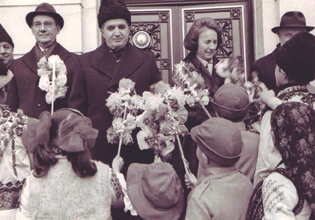The History of Romania in One Object: Ceaușescu's Personality Cult in Paintings
- RCI USA
- Jun 29, 2020
- 4 min read
Updated: Jul 27, 2020

Photo 1: "Nicolae Ceaușescu and Scenes from the History of the People". Offered to Ceaușescu by Natalia and Nicolae Gadonschi-Ţepeş on the occasion of his 54th birthday (January 1972)
Photo 2: Nicolae Ceaușescu takes the oath as President of the Socialist Republic of Romania (1974)

Nicolae Ceauşescu (1918-1989), for decades the absolute leader of communist Romania, enjoyed a cult of personality of an unparalleled dimension, at least in Europe. The mass adulation surrounding him (and his wife, Elena) developed on “fertile land” as Communist power structures and promotion practices encouraged the dictator to style himself “the Carpathian genius”, “a lighthouse of the Communist regime”, “a world renowned politician” or “the much beloved and esteemed leader”. Elena Ceauşescu was hailed as the “academician doctor engineer” and a “world renowned savant”, despite her poor education and nonexistent scientific training.
Ceauşescu’s appetite for seeing and hearing himself praised grew simultaneously and exponentially with the increase of his personal power and reached its paroxysm in the 1980s, when the grotesque glorification of the ruling couple unfolded on the background of one of the most severe economic, food and energetic crisis the country had ever seen.
Photo 3: The Ceausescu couple in the middle of the flower baskets received on the occasion of Nicolae Ceaușescu's 65th birthday on January 26, 1983
Photo 4: Nicolae and Elena Ceaușescu with a group of children on the first day of 1979
Photo 5: Meeting on the "23 August" stadium in Bucharest, on the occasion of Romania's National Day (August 23, 1986)
Photo 6: Two "Homage" paintings offered by the Sibiu County Party Committee on the occasion of Nicolae Ceaușescu's birthday in 1983 and 1989
The birthdays of the Ceauşescus represented occasions for pompous ceremonies when the two “geniuses” were showered with innumerable gifts. The range of accolades was extremely wide: grandiose manifestations on stadiums – which involved tens of thousands of people -, a never-ending stream of messages of gratitude, works of prose and poetry written especially for the occasion, celebratory editions of the National Festival “Cântarea României” (The Praise of Romania), hymns, odes, songs, dances, paintings and sculptures produced by armies of artists. The zealots of the personality cult personality placed the dictator among the authentically great figures of Romanian history. Thus, Ceauşescu shortly evolved from being “just” a “hero among heroes” to being “the Nation’s hero” and even “the most important hero of the nation’s heroes”.
Photo 7: "The Hero of Socialist Romania". Commissioned by the Olt County Party Committee and and offered to Ceaușescu in January 1988, on the occasion of his 70th birthday
Photo 8: "Representative Personalities in the History of the Homeland". Made at the Circle of Pioneers in Drăgășani. Commissioned by the Olt County Party Committee and offered to Ceaușescu in January 1978, on the occasion of his 60th birthday
Photo 9: "Homage". Commissioned by the Committee on the Issues of the People's Councils (1984).
Painted portraits counted among the most frequent and appreciated gifts offered to Nicolae Ceaușescu and his wife. The Party organizations would commission various artists to create them. Depending on the budget, the artist was a household name or a lesser-known artisan. The request could be for a painting in which Ceausescu was pictured as a defender of peace, friend and mentor of all Romanians (young or old, workers and intellectuals, women and men etc.), heir to the "great forerunners" and "millennial ideals ”, the creator of the “multilaterally developed socialist society”. Other paintings would highlight the great scientific achievements of his poorly educated spouse depicted as a member of the Romanian Academy and a Ph.D. in engineering with international scientific contributions!

Under close scrutiny, one can discern a certain common manner shared by all these portraits: the “rejuvenation”, often exaggerated, of the main characters is widely practiced; the message is optimistic, positive, conveys joy, enthusiasm; the leaders are always presented in flattering positions (they are surrounded by adoring crowds, including children and young people, they project deep knowledge and wisdom, which they share with their followers, they share de podium with great world leaders or great scientists).
In any case, the dictatorial couple had to look good. Their appearance (from clothing, posture, gestures, pose), the message they conveyed (paternal, benevolent, compassionate, friendly), the company they were in (rulers, foreign leaders and above all “the people”) – all must contribute to this iconography. Of course, most of the portraits were made after photographs as they had never posed for any painter.
Photo 10: "Nicolae Ceaușescu Takes the Oath". A commission by the Ministry of Defence (1978)
Photo 11: "Elena Ceaușescu". A commission by the Argeș County Party Committee (1983)
Photo 12: "Industrial Achievements in Călăraşi County". Commissioned by the Călăraşi County Party Committee (1985)
Photo 13: "A Work Visit to Argeș County". Offered by the Argeș County Party Committee (1982)
The paintings and other objects which were offered to Nicolae Ceaușescu and his wife at home and abroad came in such high number that they considered exhibit them in a museum. And not just in any museum, but in the largest history museum in Romania. Thus, 1978 saw the inauguration of the exhibition entitled "Evidence of love, high esteem and deep appreciation enjoyed by Comrade Nicolae Ceausescu and Comrade Elena Ceausescu, of the broad relations of friendship and collaboration between the Romanian people and the peoples of other countries". Or, in short, "Homage"! It came to occupy over 27,000 sq ft and counted over 10,000 objects (including the "diplomatic" gifts received during official meetings in Romania and abroad).
THE HISTORY OF ROMANIA IN ONE OBJECT, our new online program that evokes decisive epochs in the Romanian past starting from objectc with powerful symbolic and representative value, is developed in partnership with The National History Museum of Romania. Text and video presentation by historian Cornel Ilie.
Photos by Marius Amarie




















